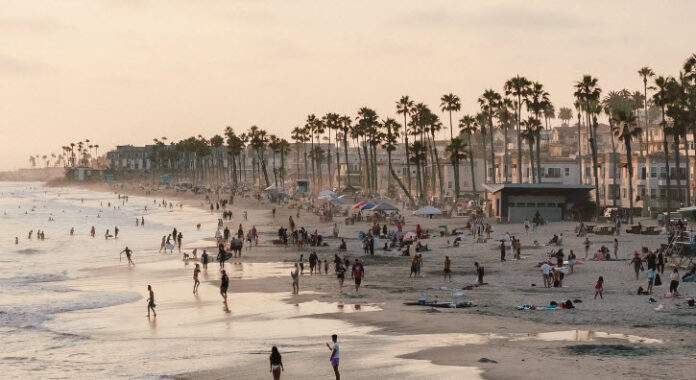OCEANSIDE, CA – Last week, the Oceanside City Council voted unanimously to approve moving forward with International Coastal Management’s (ICM) “Living Speed Bumps” concept to restore and preserve sand on Oceanside beaches. This innovative concept emerged from RE:BEACH, a nearly year-long global design competition that included three world-renowned design firm finalists and extensive public input.
Oceanside is taking proactive measures to build coastal resiliency and restore the shoreline with ICM’s solution that has proven effective on Australia’s Gold Coast. In his presentation to City Council last week, Principal Engineer of ICM, Aaron Salyer, reviewed the vast similarities between Oceanside and the Gold Coast, underscoring his confidence in the success of the pilot project combined with an adaptive management approach.
“ICM’s idea, the ‘Living Speed Bumps,’ taps into their experience along Australia’s Gold Coast. This innovative concept involves building two small headlands and an offshore artificial reef for both back beach and sandbar maintenance, drawing from decades of successful strategies on dynamic coastlines similar to our own,” said Jayme Timberlake, Oceanside’s Coastal Zone Administrator. “I’m thrilled with the approval of the ‘Living Speed Bumps’ concept. By piloting this project, the City is taking proactive measures to responsibly address both chronic coastal erosion and sea level rise stressors along our shoreline, while adding another coastal management tool to the toolbox.”
ICM’s headlands concept brings new opportunities to Oceanside, offering an innovative approach to manage sediment resources, improve beach access, and potentially enhance coastal habitats, with a focus on managing surf resources and recreational opportunities for North County residents.
The concept adopts an approach to work with coastal processes through mimicking natural coastal features in California, such as headlands and reefs. Just like in nature, these features are expected to dampen the erosion of sand from the beach and from the sandbars, which increases the efficiency of sand management activities and prolongs the retention of placed sand along the shoreline. A strong focus is on ensuring the design prioritizes safety for surfers and swimmers, contributing to an enhanced beach experience.
“We want to protect and restore our beaches and coastal habitat”, said Bob Ashton, CEO of Save Oceanside Sand and RE:BEACH Jury member. “At our core, Oceanside is a beach town. Our beach is the life-blood of our city, recreation, relaxation and economic resilience are all key drivers and preserving sandy beaches should be a top priority, and I am thrilled that the council took action to unanimously support this.”
The RE:BEACH competition sought to bring forward the most innovative, multi-beneficial and viable solutions for restoring and preserving Oceanside’s sandy beaches. The global call to action in 2023 invited landscape architecture and coastal engineering firms to participate, yielding proposals from six different teams. After reviewing those initial proposals, the RE:BEACH project team narrowed the field to three finalists: ICM, Deltares/MVRDV and SCAPE/ESA. Together, the teams collected hundreds of comments, in person and online, from numerous residents and community groups through a three-part Public Workshop series. An esteemed jury, consisting of local, state, and national experts, played a crucial role in ultimately recommending ICM’s design as the preferred solution, which was then brought to the Oceanside City Council at the recent workshop.
“With a unanimous Council decision and the broad base of community members that came out to support the RE:BEACH process; a coalition of partners has been built that will work together to see that this project is implemented and can serve generations of Oceanside residents. Resilient Cities Catalyst is excited to continue to support this important work.” –Samuel Carter, Founder and Principal, Resilient Cities Catalyst
“We are thrilled for the unanimous Council approval to move forward with the next steps in designing the RE:BEACH pilot project,” replied Brian Leslie, Senior Coastal Scientist with GHD. “The design competition brought forward many creative strategies, and we feel the reef and headland concept pitched by ICM fits well with Phase 1 efforts. This is an exciting opportunity to expand tools for coastal management in California.”
The next step for this pilot project is to conduct a siting analysis to objectively describe how the pilot could be sited within three segments south of Oceanside Pier. The analysis is anticipated to present preliminary results at a public workshop in Summer 2024, followed by a Fall 2024 City Council Workshop to consider approval of the location. GHD will continue to serve as the prime consultant and will contract with ICM and work together with the City to prepare final engineering plans, conduct environmental reviews, and obtaining permits for the project in the next 1—2 years.
“This opportunity perfectly aligns with our deep passion for impactful projects, and we are confident that Oceanside will emerge as a shining example of coastal resilience in California,” said Aaron Salyer, Principal Engineer and Director at ICM. “Our commitment extends beyond design; we eagerly anticipate contributing our extensive expertise in implementation, monitoring, and management of dynamic coastal environments to ensure the success of this exciting project.”
Stay updated on the progress of the “Living Speed Bumps” project through the City of Oceanside’s website and the RE:BEACH website at rebeach.org.
About RE:BEACH
RE:BEACH is a Coastal Resilience Design Competition that brought together three design teams from around the world to develop innovative sand retention pilot projects for the City of Oceanside. The winning team and their design will move into final engineering and permitting in early 2024.


















